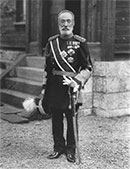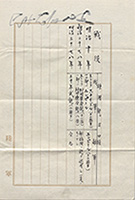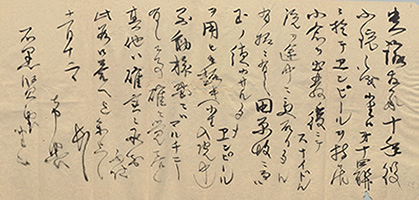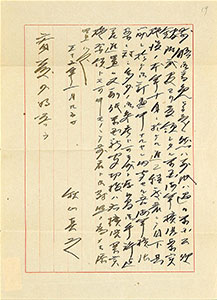Chapter 4 Military men in Russo-Japanese War
TOGO Heihachiro, 1847-1934
 Togo was a naval officer during the Meiji and the Showa eras. Born into a family of feudal retainaer from the Satsuma Domain, he studied in the United Kingdom and played an active role during the Sino-Japanese War as captain of the cruiser Naniwa. During the Russo-Japanese War, he achieved fame as Commander-in-Chief of the Combined Fleet for defeating the Baltic Fleet of the Russian Navy in the Battle of Tsushima Strait. Thereafter, he served as the president of Togu Gogakumonjo (School for the Crown Prince in his Palace) and was later promoted to admiral of the fleet.
Togo was a naval officer during the Meiji and the Showa eras. Born into a family of feudal retainaer from the Satsuma Domain, he studied in the United Kingdom and played an active role during the Sino-Japanese War as captain of the cruiser Naniwa. During the Russo-Japanese War, he achieved fame as Commander-in-Chief of the Combined Fleet for defeating the Baltic Fleet of the Russian Navy in the Battle of Tsushima Strait. Thereafter, he served as the president of Togu Gogakumonjo (School for the Crown Prince in his Palace) and was later promoted to admiral of the fleet.
67 Togo Heihachiro shokan, June, 1907[Oyama Iwao Papers (deposit): 32-135]
This letter to Commander-in-Chief of the Japanese Army Oyama Iwao was written by Togo while he served as chief of the naval general staff. In the letter, Togo describes to Oyama classified Russian military documents and other materials that he had obtained during the Russo-Japanese War and which he is sending to Oyama. Togo served as Commander-in-Chief of the Combined Fleet and Oyama as the Commander-in-Chief of the Japanese Army in Manchuria during the Russo-Japanese War, and both are credited with major contributions to Japan’s victory.
NOGI Maresuke, 1849-1912
 Nogi was an army officer during the Meiji era. He was a retainer of the Choshu Domain and later commissioned as an officer in the Imperial Japanese Army during the Satsuma Rebellion and the Sino-Japanese War before being appointed Governor-General of Taiwan. During the Russo-Japanese War, he directed the capture of Port Arthur Lüshun as Commander of the Japanese Third Army. Having won the confidence of Emperor Meiji, he was later appointed President of Gakushuin. After the death of Emperor Meiji, Nogi and his wife famously committed suicide, following their Emperor to the grave.
Nogi was an army officer during the Meiji era. He was a retainer of the Choshu Domain and later commissioned as an officer in the Imperial Japanese Army during the Satsuma Rebellion and the Sino-Japanese War before being appointed Governor-General of Taiwan. During the Russo-Japanese War, he directed the capture of Port Arthur Lüshun as Commander of the Japanese Third Army. Having won the confidence of Emperor Meiji, he was later appointed President of Gakushuin. After the death of Emperor Meiji, Nogi and his wife famously committed suicide, following their Emperor to the grave.
68 Nogi Maresuke shokan, November 21, 1905[Ishiguro Tadanori Papers: 926]
This letter was written by Nogi to Ishiguro Tadanori. The Russo-Japanese Peace Treaty was signed on September 5, 1905, and ratified by the Japanese government the following October 14. As commander of the Japanese Third Army, Nogi set out in December from Hokamon in northern Fengtian to return to Japan. This letter was written in Hokamon, while Nogi was awaiting demobilization, and is in response to an inquiry from Ishiguro about the guns used in the Satsuma Rebellion, the Sino-Japanese War, and the Russo-Japanese War. Ishiguro, who was responsible for establishing the Japanese Army’s medical corps, was a commissioner at the Army’s temporary quarantine headquarters in Tokyo at the time.
AKIYAMA Saneyuki, 1868-1918
 Akiyama was naval officer during the Meiji and the Taisho eras. After graduating from the Naval Academy, he studied in the United States and became an instructor at the Naval War College. During the Russo-Japanese War, he played an important role in developing naval strategy as a staff officer of the combined fleet. He was promoted to vice admiral in 1917.
Akiyama was naval officer during the Meiji and the Taisho eras. After graduating from the Naval Academy, he studied in the United States and became an instructor at the Naval War College. During the Russo-Japanese War, he played an important role in developing naval strategy as a staff officer of the combined fleet. He was promoted to vice admiral in 1917.
69 Akiyama Saneyuki shokan, January 25, 1902[Saito Makoto Papers, Letters: 254]
This letter was written to Naval Chief of Home Affairs Saito Makoto by then Lieutenant-Commander Akiyama, who was a staff officer assigned to the regular fleet. Akiyama describes a progress report on the implementation of the U.S. naval planning and other documents to be used as reference in Japan’s naval planning. Having been involved in the implementation of the first of three phases as a vice minister of the Navy, Saito played an active part in naval expansion planning after the Sino-Japanese War. Akiyama would later serve as a staff officer aboard the battleship Mikasa, which was the flagship of the combined fleet at the Battle of Tsushima Strait during the Russo-Japanese War and which was built in the United Kingdom as part of this plan.










